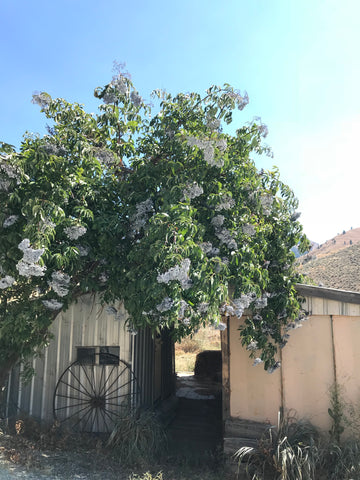Do you want to grow elderberry for food, medicine or to improve native habitat? Today we'll introduce the basics of how to grow blue elderberry in your yard.

Scientific binomial name: Sambucus nigra var. cerulea or Sambucus cerulea
Sambucus cerulea, Blue Elderberry, or Mexican Elderberry is native up and down the west coast of North America, and all the way to the west side of the Rocky Mountains. This variety is beautiful and drought tolerant – a great choice if you want to support biodiversity and your local pollinators. We’ve created this guide to help gardeners increase biodiversity in their own landscape with our favorite elderberry plants.

Elderberry thrives in full sun and partial shade. Full sun is 6 or more hours of direct sunlight per day. Partial sun is 3 to 6. They like the boundaries of forests and often live amongst the evergreen giants at the edge of meadows, getting partial shade and loving it. They also particularly like being in valleys, even if the water isn’t right up next to their feet. They do great as border plants in hedgerows or corridors to residential properties and farms, creating a natural boundary and habitat for creatures big and small. The key to drawing in birds is a variation in sizes of plants and types of plants, creating many spots for them to hop from branch to branch out of the open where they can fall to predation.
These plants love their neighbors so try to make sure you have space to grow 2, 3, 5, or more together. Try to ensure there is enough space, 3-6 square feet per plant should be sufficient. This will increase pollination, leading to higher yields of berries. For new plantings, keep soil moist. Mulch well around the base and keep the mulch moist. This may mean a few deep waterings per week for the first month.

Depending on how hot it is, it could mean daily watering to help the plants get established. Water deeply rather than more frequently. Water at night or in the evening to avoid losing water to evaporation. Saturate the root zone and watch it soak into the ground. It’s a great meditation and a lot more effective than spraying water on the plant parts above the ground. After a year, you will be able to see when an elder tree looks droopy enough to warrant a drink of water, this may be a few times per week during hot months, or as little as once a month after becoming established. Elderberry is semi deciduous and may loose it's leaves over winter. It's likely not dead! Just focusing on root growth and resetting foliage for the following spring to produce new growth.
Where to get them? If you want them shipped to your door - Strictly Medicinal Seeds, Raintree nursery, or One Green World are good options. If you want to source them locally, do an online search for "[your city] + native plant nursery", call them up and ask for your native elderberry – either Blue Elderberry or American Elderberry. Calscape has a list of nurseries carrying Blue Elderberry in CA.

When you plant native landscapes, you improve biodiversity and sustain healthier ecosystems. Our view of tidy and weedless lawn-scapes is left over from colonial era expectations of aesthetics that have been covered in plenty of articles elsewhere. The bottom line is that going native can save water, reduce pesticide use, and provide habitat for a much greater variety of animals, plants, and fungi.
Happy planting!
Note: Dr. Appleseed's wild harvested unsweetened elderberry extract contains 100% blue elderberries, a pure immune supplement, with no other ingredients. Your purchase supports native elderberry plantings and education projects to increase biodiversity in our local landscapes.

